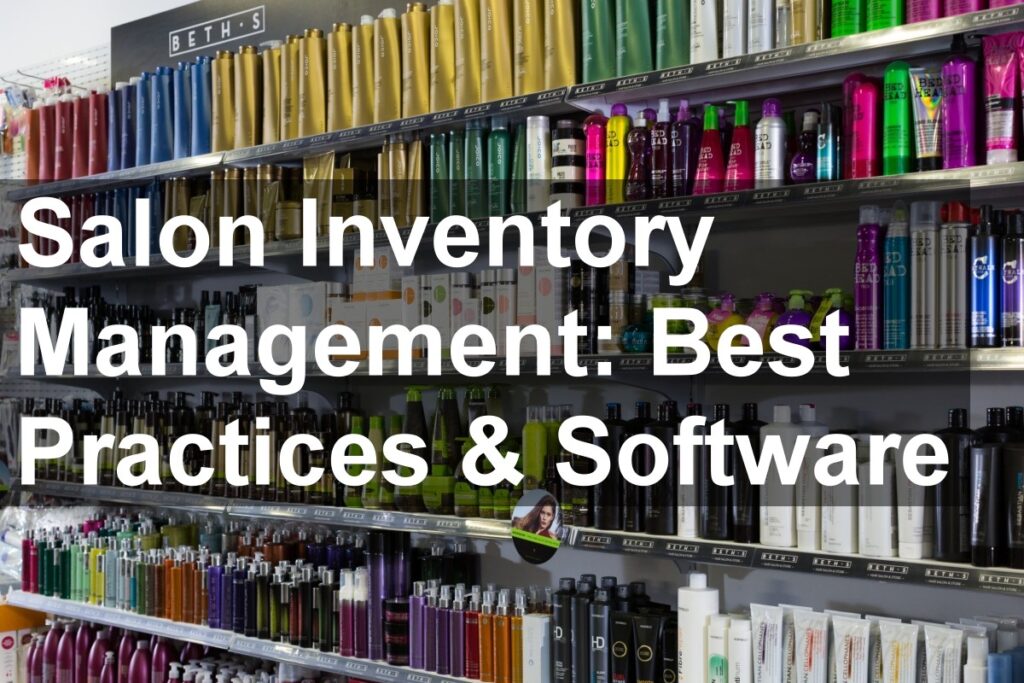 Introduction
Introduction
Inventory management plays a crucial role in the smooth operations and profitability of any kind of salon within the beauty industry. With a wide range of products and constant customer demand, it is essential for salon owners to have an efficient system in place to track and manage their inventory effectively. One recommended solution is implementing a comprehensive software suite that handles inventory management and possibly other aspects of running the salon.
There are many such software products on the market and they can streamline the entire process, from organising inventory to tracking product usage and making data-driven purchasing decisions. But before we get into software, let’s first look at some general aspects of keeping your products in check.
Categorise and Label Products
To effectively manage the inventory of all the stock in your salon, it is crucial to create categories for different types of products such as hair care, colouring, skincare and so on. This categorisation allows for easy identification and retrieval of products when needed. Additionally, each product should be labeled with its name, brand, and any other relevant information. This labeling system helps staff members locate specific items quickly and accurately.
Using storage bins or shelves is the basic first step to keep products organised. By assigning specific areas for each category of products, you can ensure that everything has a designated place. This organisation not only saves time but also prevents confusion or misplacement of items.
Plus this also benefits your customers too as they will be more easily able to browse when in the salon. If you have random products all over the place you will be losing out on potential sales opportunities as some products are just not seen.
Establish Minimum and Maximum Stock Levels
Determining the minimum quantity of each product that should be in stock is crucial to avoid running out of essential items. Salon owners should analyze sales trends and customer demand to set appropriate minimum stock levels. On the other hand, setting maximum stock levels helps prevent overstocking and tying up unnecessary capital in excess inventory.
We recently put out a guide to creating a membership system in your salon and encouraging your customers to sign up to such a membership helps you more easily manage your stock levels as you get a better idea ahead of time of what products you are going to need and when.
Implement a First-In, First-Out System
The first-in, first-out (FIFO) system is a computing term which is applicable to a broad range everyday problems. For salons, what this does is ensures that older products are used before newer ones. This system is particularly important in situations where the products that you are using have expiration dates.
You should arrange your inventory based on expiration dates to prioritise the use of older products first. Training staff members on the importance of following the FIFO system is essential to prevent product wastage due to expired items.
Regularly checking and rotating products is necessary to maintain freshness and quality. By periodically reviewing inventory and removing expired or damaged items from circulation, you can ensure that customers receive only top-quality products during their visits.
Using Inventory Management Software

In this article I’m not going to go into specific products as being an agency and not a salon ourselves, we don’t use the software in our own business and so we can’t make specific recommendations. This list from GetApp will get you started and from there you can search for reviews. What we’ll do here is tell you what features you need to look for when you’re selecting the software.
Choose the Right Software
Most software options are going to do a lot more than just help you manage the inventory; that is likely to be just one aspect of the software. Most of the options on the market today are ‘full service’ software suites that offer to help you manage every aspect of running your salon. This is good in one way because it means that you’ll only have to buy and learn a single product, but a potential downside is that not all the features may be fully built out.
Look for software that offers robust inventory tracking capabilities, purchase order management functionality, and reporting capabilities. These features will allow you to monitor stock levels, streamline purchasing processes, and make data-driven decisions.
Additionally, ensure that the software has a user-friendly interface that is easy for your staff to navigate or you’ll end up having to do more training with them. Compatibility with existing salon management systems is also crucial for seamless integration and efficient operations.
Any reputable software company is going to have a strong online presence so make sure to look for one that has very good reviews, particularly from other salon owners who are using their software.
Input and Update Inventory Data
Computer software is only ever as good as the data which is fed into it! It is essential to input accurate and detailed product information into the system or it just isn’t going to be particularly effective. This includes names, quantities, prices, suppliers, and any other relevant details. Regularly updating this data is important to reflect changes in stock levels due to sales or new purchases.
To expedite the process of updating inventory data, consider utilising barcode scanning or RFID technology. These technologies enable faster and more accurate inventory management by scanning product barcodes or RFID tags. By simply scanning items as they are received or sold, you can easily update stock levels in real-time.
Track Sales and Stock Movements
One of the significant advantages of using salon inventory management software is its ability to track sales data and stock movements. By monitoring sales trends, you can identify popular products that require higher stock levels or promotions. This helps prevent stockouts while optimising customer satisfaction.
Tracking stock movements allows you to identify any discrepancies or potential theft within your salon’s inventory. The software can generate reports on stock movement patterns, enabling you to investigate any irregularities promptly. Utilize the reporting features of the software to gain insights into product performance and make data-driven decisions regarding purchasing or restocking.
Use a Centralised Inventory Location
Designate a specific area or room within your salon to store all inventory items. This centralised location ensures that all products are in one place, making it easier for staff members to locate and retrieve items when needed. It is important to ensure that the inventory location is secure, well-organized, and easily accessible to authorized personnel only. Implementing strict access controls helps prevent unauthorized handling of inventory and reduces the risk of theft or loss.
Stock Audits

Regular audits are essential for maintaining accurate inventory records and identifying any discrepancies. Set a regular schedule for conducting physical inventory counts. This could be monthly, quarterly, or annually, depending on the size and complexity of your salon’s inventory. Assign trained staff members to perform the audits accurately and efficiently. These individuals should have a keen eye for detail and be familiar with the salon’s inventory management processes.
During the audit, compare the physical counts with the inventory records to identify any discrepancies. This process helps uncover issues such as theft, data entry errors, or misplacements. By conducting routine audits, you can maintain accurate stock levels and ensure that your inventory records align with what is physically present in your salon.
Investigate Discrepancies and Take Corrective Actions
If discrepancies are found during the audit, it is crucial to investigate their root causes. This could involve reviewing security footage, interviewing staff members, or examining data entry logs. Identify whether the discrepancies are due to theft, human error, or other factors.
To prevent future discrepancies, implement measures such as enhanced security measures or additional training for staff members involved in inventory management. Updating inventory records to reflect accurate stock levels after completing the audit ensures that your system remains up-to-date.
Regularly Analyse Audit Results
Regularly analysing audit results allows you to identify patterns or trends in inventory discrepancies. Look for common areas where errors occur or specific products that consistently show inconsistencies between physical counts and recorded data. Use this information to improve your overall inventory management processes and reduce errors.
Sharing the findings with staff members creates awareness about the importance of accurate inventory management and promotes accountability within your team. By involving your staff in this process and encouraging their input on improving procedures, you can work together towards more efficient operations.
By conducting regular audits, investigating discrepancies thoroughly, and analyzing audit results regularly, salon owners can maintain accurate inventory records while continuously improving their overall inventory management processes.
Reporting

Take advantage of the reporting capabilities offered by your salon inventory management software. Generate reports on stock levels, sales trends, and product performance. These reports provide a comprehensive overview of your inventory, allowing you to identify areas of strength and areas that require improvement.
Analysing these reports enables you to make data-driven decisions regarding inventory management. For example, if certain products consistently have low stock levels or high demand, you can adjust your restocking quantities accordingly. By staying informed about your inventory status through regular reporting, you can ensure that you always have the right products in stock to meet customer demand.
Identify Slow-Moving or Obsolete Products
Reviewing inventory reports helps identify slow-moving or obsolete products. These are items with low sales or those nearing expiration dates. By identifying these products, you can take necessary actions to prevent overstocking and minimize financial losses.
Consider offering promotions or discounts on slow-moving products to stimulate sales and clear out excess inventory. If certain items consistently underperform despite promotional efforts, it may be time to discontinue them from your product offerings. This allows you to free up shelf space for more popular and profitable products.
Forecast Demand and Plan Purchases
Utilise historical sales data and market trends to forecast future demand for different products. By analyzing past sales patterns, you can anticipate when certain items will experience increased demand or seasonal fluctuations. Use this information to plan purchases accordingly and ensure optimal stock levels.
Avoid stockouts or overstocking by aligning your purchases with anticipated demand. By accurately forecasting demand, you can maintain a well-balanced inventory that meets customer needs without tying up unnecessary capital in excess stock.
By leveraging the reporting features of your salon inventory management software, you gain valuable insights into your inventory performance. Generating reports, identifying slow-moving or obsolete products, and forecasting demand allow you to make informed decisions that optimize your inventory management processes while maximizing profitability.
Conclusion
Effective salon inventory management is essential for the smooth operations and profitability of a salon. By implementing a comprehensive salon inventory management software, salon owners can streamline their operations, reduce costs, and optimize their inventory management processes.
Organizing inventory, setting up tracking systems, conducting regular audits, and utilising reporting features are key steps in achieving efficient inventory management. These tools and techniques help salon owners maintain accurate stock levels, prevent stockouts or overstocking, identify slow-moving products, and make data-driven decisions.
By implementing good business practices and leveraging software solutions like inventory management software, salon owners can ensure that they have the right products available when needed while minimizing waste and maximizing profitability.

